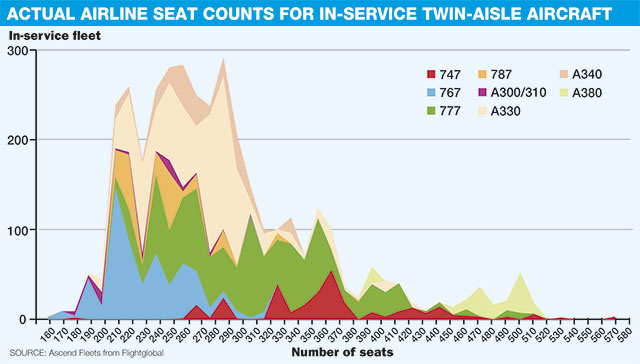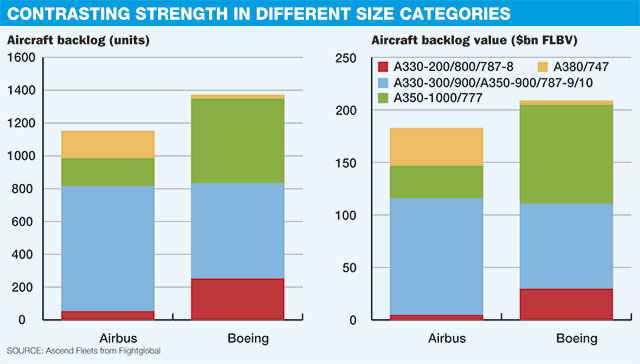Ascend senior consultant Richard Evans considers what aircraft manufacturers may do next in the twin-aisle market
The last five years have brought an unprecedented surge in new commercial jet programmes across the regional jet, single-aisle, and twin-aisle markets. Several new types have entered service, and many new developments have been launched for entry into service later in the decade. Aircraft manufacturers have committed huge resources to delivering these programmes, and will presumably want to continue to effectively utilise their teams of engineers into the 2020s. The big question is: what will be the next types to emerge from Toulouse, Seattle or elsewhere?
If we review the three main aircraft sectors, it might be concluded that the market is now fully catered for, with all-new aircraft or re-engined types spanning the regional, single-aisle, and twin-aisle markets across all size bands. The twin-aisle sector has had the Boeing 787-8, 787-9 and Airbus A350-900 enter service, and several other programmes are under development.
The next new twin-aisle to enter service will be the A350-1000 in the second half of 2017, followed shortly afterwards by the A330-900neo. The year 2018 will bring the first deliveries of the 787-10 and the A330-800neo. To complete the set of new twin-aisle aircraft, Boeing will deliver the first 777-9X in 2020 and the first 777-8X a year later.
China and Russia are in the early stages of a joint programme to build a 300-seater, with a 5,400-6,500nm (10,000-12,000km) range and Western engines.
The twin-aisle market thus looks to be very well addressed by new types and variants. If we look at the in-service fleet, split into generic size categories, the global fleet has now concentrated in three sectors of 250, 300 and 350 seats, with the smallest (200 seats) and largest (450-plus seats) twin-aisles dwindling to very small fleet shares.
A couple of questions arise. Does this reflect demand, or does this reflect where the most competitive aircraft sit today, on a payload-range and cost-per-seat basis? Do actual airline seating layouts reflect this generic categorisation?
The actual number of seats in today's fleet are shown below. This highlights the fact that 70% of the fleet has between 200 and 320 seats installed. Above this size, there is a sharp reduction in the fleet, and only 10% of the fleet has more than 380 seats aboard. The chart also shows the huge variation in seat counts across a single aircraft type.

This data would suggest that the next new twin-aisle development could fit in the space above 320 seats. Boeing will be addressing this with the 777-9X, which has a manufacturer's seat count of 407, but will more realistically average perhaps 370-380 seats. The A350-1000 will also fit in this size bracket, but there could be pressure on Airbus to develop a larger version to respond to the 777-9X.
New twin-aisles developed between 1980 and 2005 generally offered more payload range or filled an obvious size gap in the manufacturer's portfolio – or both. However, the longest-range types developed failed to sell in significant numbers, suggesting that new types have to demonstrate significantly lower cost per seat to succeed. The 787 and A350 do not offer more range, and so, costs have to be reduced. Of course, one way to lower unit costs is to install more seats, and it is noticeable that most airlines will replace their 767s or early A330-200s with aircraft with more seats. We will probably therefore see the left-hand end of the fleet edge upwards from 200-220 seats to 230-250 seats.
This increase in seat count at the bottom of the twin-aisle market fuels the argument that the next twin-aisle development might be an all-new type to fit above the A321 and below the 787-8. Bear in mind that the gap in seats is actually much bigger than at first glance. This is because the single-aisles with 200-plus seats are operated in high-density layouts, whereas many of the twin-aisles with 200-240 seats are flown in spacious two- or three-class layouts. For any new aircraft to succeed in this space, it will need to offer very low unit costs – almost certainly meaning an all-new type – in order for airlines to either grow routes upwards from efficient single-aisle aircraft or to launch new thin long-haul routes.
The last clue to examine is the competitive position in twin-aisles between Airbus and Boeing. The charts below show the firm order backlog, in terms of both units and value, split into appropriate competitive size brackets, which we could call small, medium, large and very large.

Boeing has a lead in both units and value terms, although Airbus is ahead in both the medium size and the very large sectors. However, the new 777-9X offers an aircraft with similar cost per seat to the A380, and the lack of new orders for the A380 has been well documented.
In fact, Boeing has a larger backlog in the large size band (777 and 777X) than the combined large and very large bands (A350-1000 and A380) for Airbus. In the small twin-aisle market, it appears Airbus is also under pressure. However, Boeing's backlog on the 787-8 is rapidly shrinking, and it is likely that most future orders will be for the larger 787-9 and -10 versions. Therefore, Airbus can perhaps be more relaxed here.
WHAT'S NEXT?
Clues as to the next twin-aisle developments have been examined from several angles.
The current seating distribution suggests the obvious gap is above 320 seats. Boeing is better placed here with the larger 777-9X, so Airbus may want to develop the A350-1000 further or perhaps eventually build a new type larger than the A350. The latter would involve a massive investment so is perhaps unlikely. It would additionally also likely spell the end of the A380, although that could happen without this development anyway.
Airlines are moving upwards in size, with the large fleet of 767s being replaced by larger aircraft. This could create a gap for an aircraft around the same size as the 767-200 or A300. However, this presents a huge challenge to match the unit costs of both large single-aisles and the 250-300-seater twin-aisles, while paying back a $10-20 billion development cost.
Finally, although there continues to be limited demand for aircraft with more than 500 seats, Airbus will be forced to react to the very low unit costs of the 777-9X, which will seemingly be lower than those of today's typically configured A380. Without some form of development, sales of the A380 may wither away quickly. Therefore, however challenging the business case looks, an A380neo may well be Toulouse's next move in the twin-aisle market.
Source: Cirium Dashboard























